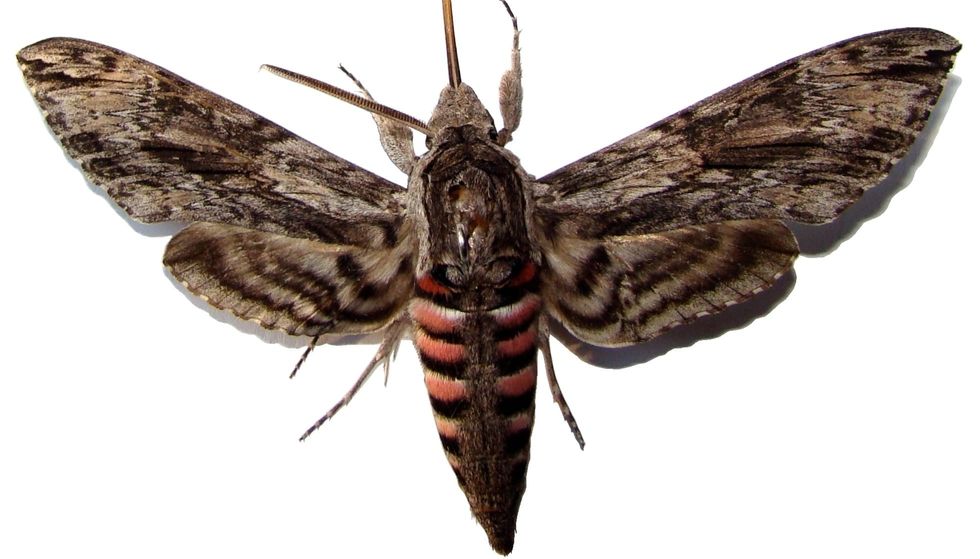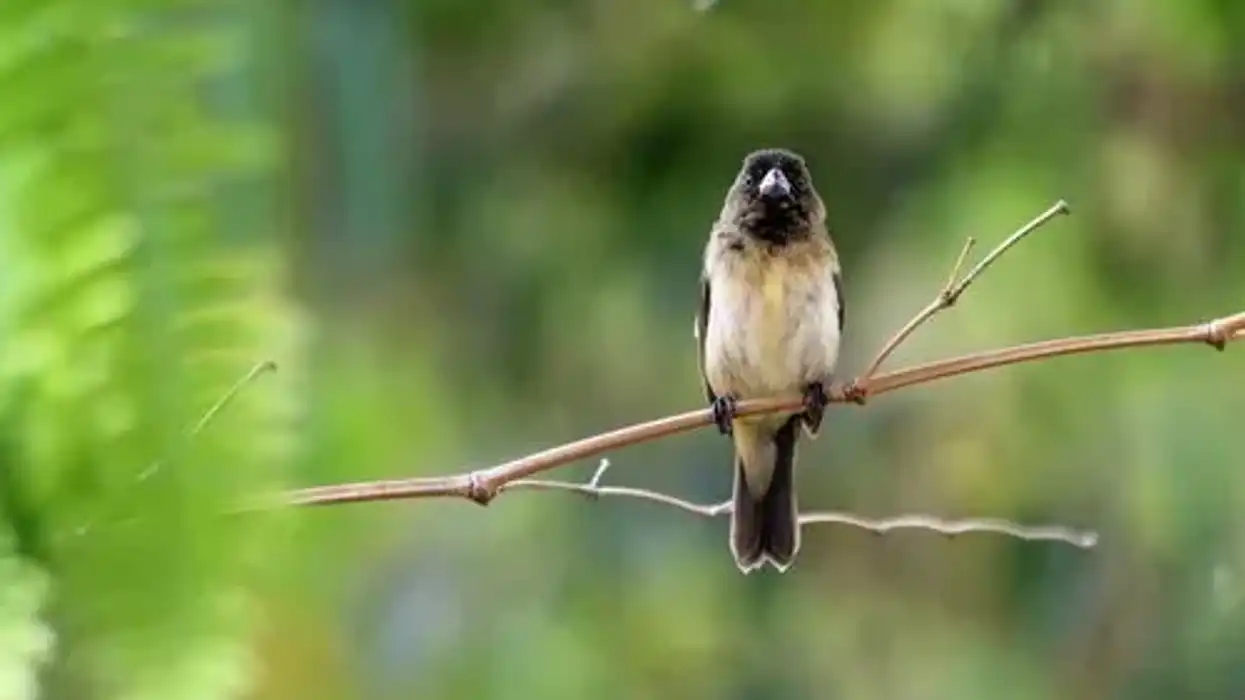Are you interested to know more about interesting insect species? If yes, then hold tight as in this article we are going to talk about a commonly found moth, the convolvulus hawk moth (Agrius convolvuli).
This large-sized nocturnal moth is placed in the order Lepidoptera, the family Sphingidae, and the genus Agrius. The Agrius convolvuli caterpillar is known for eating plants from the convolvulus species, while the adult moth often feeds on tubular flowers.
However, the tobacco plant is also a common host. This moth is often seen in a garden or other open spaces, and it likes warm areas.
In a garden, you may also find its bright red or mahogany pupa burrowed into the ground. Adults have brown wings and a few stripes on their bodies.
Want to know more about this species? Keep reading to find more convolvulus hawk moth facts. Also, check out articles on the lime hawk moth and the privet hawk moth.
Convolvulus Hawk Moth Interesting Facts
What type of animal is a convolvulus hawk moth?
The convolvulus hawk moth (Agrius convolvuli) is a form of large moth belonging to the Sphingidae family. The five spotted hawk moth is also from the same family.
What class of animal does a convolvulus hawk moth belong to?
The convolvulus hawk moth belongs to the class Insecta, the order Lepidoptera, the family Sphingidae, and the genus Agrius. The puss moth is another insect, like the convolvulus moth.
How many convolvulus hawk moths are there in the world?
As it is a widely found moth species, we cannot really find out the exact population of the convolvulus hawk moth.
Where does a convolvulus hawk moth live?
The convolvulus hawk moth (Agrius convolvuli) is found in different parts of Europe, Asia, Africa, Australia, and New Zealand. In Europe, these moths mainly inhabit warmer southern parts, but it is also common to see them migrating to northern parts.
We are yet to know if it's endemic to a particular place. This moth is common in UK gardens during summers, but overwintering isn't common as the hawk moth cannot stand the cold.
What is a convolvulus hawk moth's habitat?
This species likes to reside in warmer areas, so these moths can often be seen in warm, open areas. Agricultural steppes are one of their most common habitats.
However, you may often see these moths in a garden, or on hedges and roadside verges. These are nocturnal moths, so you may need to wake up in the wee hours of the morning to catch it in your garden while feeding on flowers.
Who do convolvulus hawk moths live with?
The life of a moth is usually solitary except when it comes in contact with a mate. In its stage as a caterpillar, it will often share plants with its siblings, but we don't know if there is any communication between members of this species.
How long does a convolvulus hawk moth live?
The average lifespan of a convolvulus hawk moth (Agrius convolvuli) is around 10-30 days for both male and female moths. Its pupal stage in life can be the longest, as in some areas, it can last for up to six months.
In the state of a caterpillar or larvae, it spends around two to four weeks munching on food plants.
How do they reproduce?
Reproduction is a key part of adult moths as the female soon collapses after depositing eggs on a host plant. When it comes to the convolvulus hawk moth, the flying time is around May to October. The female deposits up to 200 eggs on plants.
These eggs are usually blue-green and later change to a more yellowish tinge. It takes 10-15 days for eggs to hatch so that larvae can come out.
An interesting thing about this moth species is that caterpillars can be of different colors. Apart from the usual bright green, some can also be brown with lots of stripes. This change of color can also depend on the instar stage of the caterpillar or larvae.
Another interesting thing about hawkmoths is that pupae are formed underground rather than on plants or flowers. Pupae are strikingly beautiful with a shiny mahogany appearance along with a jug handle proboscis.
During the summer it takes around 17-26 days for the pupa to turn into an adult. In a colder climate, it can take four to six months for the adult hawkmoth to come out.
What is their conservation status?
The convolvulus hawk moth (Agrius convolvuli) is yet to be listed on any conservation lists.
Convolvulus Hawk Moth Fun Facts
What does the convolvulus hawk moth look like?
Apart from the dorsal stripe of pink and black, nothing is really interesting about the adult moth. Most of its body is gray or brown, and it helps the hawkmoth to easily blend with tree bark.
It does have some white, brown, and black patterns on its wings which can only be seen with the full wingspan visible. However, the most interesting thing about this species has to be larvae and their changing colors.
Larvae can be either green or brown, but the latter color becomes prominent as the moth nears the pupal stage. When feeding on plants, the bright green body of a larva works as camouflage.
The pupa of this species is quite interesting because of its bright red or mahogany body along with the jug handle proboscis. As adults, the long proboscis is used for feeding on tubular garden flowers.

How cute are they?
We wouldn't really describe these hawkmoths as cute because they lack the charm of a peppered moth. However, the caterpillar, as well as the pupa with its proboscis, is quite a view.
How do they communicate?
We are yet to know a lot about communication in moths, but most scientists are of the opinion that pheromones play a vital role.
How big is a convolvulus hawk moth?
The size of a moth is often measured based on its wingspan. In the convolvulus hawkmoth (Agrius convolvuli), the average wingspan is around 3.1-4.7 in (80-120 mm), and this is bigger in females. Compared to the hawkmoth, the Indian meal moth has a longer body of 0.5 in (1.27 cm), with a wingspan of around 0.6 in (1.5 cm).
How fast can a convolvulus hawk moth fly?
The average flying speed of this hawkmoth is around 12 mph (19.3 kph) and is considered to be faster than many birds.
How much does a convolvulus hawk moth weigh?
The weight range of the Agrius convolvuli hawkmoth species is unknown.
What are the male and female names of the species?
There are no specific names for males or females of the Agrius convolvuli species. Females tend to have a larger wingspan compared to males.
What would you call a baby convolvulus hawk moth?
A baby convolvulus hawk moth is known by several names like caterpillar, larva, or pupa based on its life stage.
What do they eat?
Adult moths mainly survive on flower nectar to get energy. However, similar to elephant hawk-moth caterpillars that feed on various plants like rosebay willowherb, larvae or caterpillars of this species eat a lot of plants.
Common food plants for this species include the tobacco plant, and plants from convolvulus Cenus. The caterpillar may also feed on plants of the Araceae, Convolvulaceae, Leguminosae, and Malvaceae species. Feeding habits often depend on the moth's area of origin.
Are they dangerous?
No, the convolvulus hawk moth isn't dangerous or poisonous. However, it's always a good idea to handle caterpillars or larvae while wearing gloves to avoid skin irritation.
Would they make a good pet?
You wouldn't really want to keep this moth as your pet. It has a very short lifespan as an actual moth. However, if you happen to find a caterpillar, do think about observing it.
Did you know...
In New Zealand, the Agrius convolvuli convolvulus hawkmoth is known as hīhue in the native Maori language.
How many eggs do convolvulus hawk moths lay?
Each convolvulus female can lay up to 200 eggs on either the underside or upper side of a leaf.
What plants do convolvulus hawk moth caterpillars eat?
The convolvulus hawk moth caterpillar is known to feed on field bindweed and allied plants. This phenomenon gives the species its Latin name, convolvuli. In India, the caterpillar is known to feed on pulses and plants. In other places, the caterpillar has been found on the tobacco plant.
Here at Kidadl, we have carefully created lots of interesting family friendly animal facts for everyone to discover! Learn more about some other arthropods from our ground beetle facts and speckled bush cricket facts pages.
You can even occupy yourself at home by coloring in one of our free printable arthropods coloring pages.









